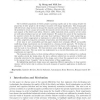Free Online Productivity Tools
i2Speak
i2Symbol
i2OCR
iTex2Img
iWeb2Print
iWeb2Shot
i2Type
iPdf2Split
iPdf2Merge
i2Bopomofo
i2Arabic
i2Style
i2Image
i2PDF
iLatex2Rtf
Sci2ools
AEI
2006
2006
Design issues for assistive robotics for the elderly
The worldwide population of elderly people is growing rapidly and in the coming decades the proportion of older people in the developed countries will change significantly. This demographic shift will create a huge increase in demand for domestic and health-care services and this in turn has the potential to create a major new market for domestic service robots that can assist with the care and support of the elderly and infirm. However, unlike industrial robots, assistive service robots are still under-developed and are not widely deployed. We analyze the nature of the requirements for assistive robotics for the elderly and argue that traditional "industrial" robot engineering approaches are either inappropriate or inadequate to tackle the key problem areas, which we identify as: safety, adaptivity, long-term autonomy of operation, user-friendliness and low costs. A key issue is user acceptability and this paper explores how seemingly difficult and possibly conflicting desi...
| Added | 10 Dec 2010 |
| Updated | 10 Dec 2010 |
| Type | Journal |
| Year | 2006 |
| Where | AEI |
| Authors | Qinggang Meng, Mark H. Lee |
Comments (0)

